Download and print as a PDF (383kB pdf)
On this page
Acute neck pain
Acute neck pain can occur when a sudden movement or jolt to the body or head causes strain to the joints, ligaments, tendons, nerves and muscles in the neck and back. Commonly seen after road traffic collisions, lifting, coughing, tripping etc.
More commonly it can occur with postural stresses, such as prolonged sitting, for example at a computer, change of activity such as moving house or taking up a new hobby.
You may experience a wide variety of symptoms. Pain is the most common symptom (often referring pain into the shoulder, arm or hand) but can include pins and needles, headaches, dizziness, nausea, problems with concentration and memory, ringing in your ears and deafness.
In most cases these symptoms are temporary and will resolve naturally. It is important to understand that the pain is not harmful, it is usually short lived and it is controllable. The symptoms often increase in the few days after an accident due to swelling in the tissues. This is a normal part of the healing process. It may take up to 6 weeks for full recovery.
Evidence shows that the most important factor in your recovery is an early return to normal activities.
Avoid
Long periods of rest / inactivity / soft collars and muscle relaxant tablets.
See your GP or return to A and E urgently if you develop:
Changes in function or loss of control of bladder or bowels, pins and needles in BOTH arms or BOTH legs at the same time, numbness in the back passage or genital area, marked weakness of the limbs / balance problems or sexual dysfunction.
Exercises and positioning
Resting for a few minutes with a roll under your neck, such as a rolled up magazine or rolling pin covered with a soft towel placed under your neck, can reduce pain. For headaches, the roll is best placed high in the neck, at the base of the skull, and for shoulder and arm pain, lower down the neck, wherever best pain relief is gained. You may experience your arm pain easing and ‘centralising’ up towards the neck.

Try not to sleep with more than two pillows under your head.
All the following exercises should ease your pain and should be done frequently throughout the day especially when your pain is present. Gradually increase the range of movement as pain allows, taking pain relief as needed to allow improved function.
1. Tuck your chin and push head gently back feeling a stretch of muscles in the back of the neck. Do this 10 times.
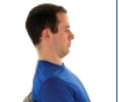
2. Hold the back of your head with one or two hands, and tip it backwards 10 times as far as you are able. Stop if this exercise always makes you feel dizzy and see your GP.
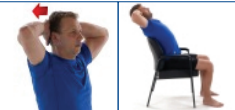
You might find it helpful to also sit in a low backed chair and stretch the middle of your back over the chair back, raising your chest slightly. This is usually helpful for pain between the shoulder blades or around the ribcage. If this always makes you dizzy and see your GP. A stretch feeling is not harmful, or causing damage and will slowly improve.
3. Maintain as much range of movement in every direction as possible. It is normal to feel a stretch of muscles as they tend to tighten if not moved to full range of movement. Use your neck as normally as possible during the day. A stretch feeling is not harmful, or causing damage and will slowly improve.
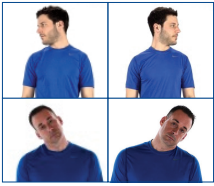
Keeping the nervous system moving
Sit on a bed or as high a chair as you can, so that you can swing your legs freely. Straighten one leg out in front of you, bend it again and repeat with the other leg, doing 20 rhythmic swings each leg. If you feel a gentle pull in your spine, (neck, middle or lower back) this exercise should be done very gently twice a day until no pull is felt in the spine.
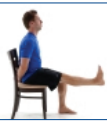
Sitting supported
Whenever you have to sit, especially if travelling, or at work at a desk for sustained periods of time, it is important to remember to always maintain normal spinal curves. There should be a small curve in your lower back, which can be maintained by rolling up a towel or cushion in the lower back and sitting back into your chair, avoiding lower back strain and stress. Try to get up and move around as often as possible.
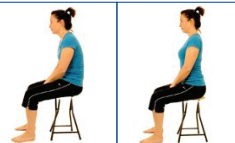
The information in this leaflet is for guidance purposes only and is in no way intended to replace professional clinical advice by a qualified practitioner.